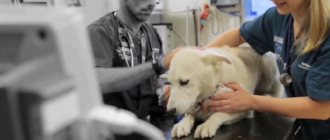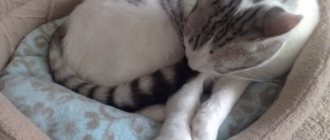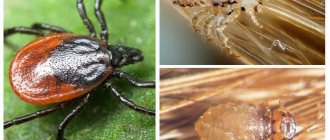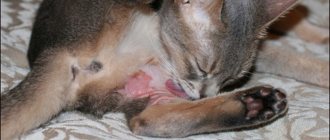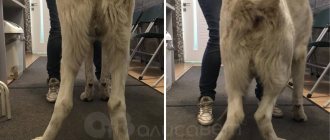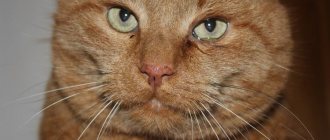A change in gait due to impaired function of the limbs - lameness - is not an independent disease, but a symptom, most often a sign that the animal is in pain. Cats are very active animals, and the sight of a domestic cat limping on a front or back leg often does not cause concern to the owner. However, the causes of lameness are not always harmless, so the owner should know why it can develop and what measures are necessary to eliminate it.
Why does a cat limp on his front leg: injury
As already mentioned, it is for this reason that a cat begins to limp on its paw most often. If the owners notice that it is difficult for their pet to step on its front paw, they should simply remember if anything has happened recently that could cause the injury. A cat may limp, for example, after an unsuccessful jump. Also, an animal’s paw may begin to hurt after someone steps on it, pinches it in a door, etc. In addition, quite often a similar problem is observed in those cats that are allowed to walk outside. A pet can get injured from other animals, after an unsuccessful jump, etc.
Lameness due to injury can range from mild to severe. In any case, if such a problem is discovered, your pet should be examined first. If the lameness is caused by an injury, a wound or swelling will likely be found on the paw. In this case, the animal owner should just wait a day. Most likely, the cat's injury, if he can still step on his paw, will go away after this time.
If the cat does not stop limping after 24 hours, you should take him to the veterinarian. The doctor will examine the animal, make the correct diagnosis and prescribe treatment.
The reasons why the cat began to limp on its front leg could be:
- cuts and punctures;
- fractures and dislocations;
- splinters.
Also, a cat, for example, can break a claw if it jumps unsuccessfully. In this case, the animal will subsequently experience quite severe pain for a long time and, accordingly, will begin to limp.
Treatment
Therapeutic measures carried out in a clinical setting depend on the identified cause of lameness.
- Dislocation.
The animal is given local anesthesia and the dislocated joint is adjusted, then a fixing bandage is applied. - Fracture.
The cat is given local or general anesthesia if the fracture is open, bone fragments are removed from the wound, and damaged tissue is excised. After this, a plaster cast is applied to the paw. - Hip dysplasia.
The basis of drug therapy is a course of chondroprotectors (Artroglycan, Cosequin, ArthroVet, Joint Max, Stride Plus, Chondartron). If necessary, the cat may be prescribed intra-articular injections of absorbable drugs and/or hyaluronic acid. In severe cases, surgical removal of the femoral head that has lost functionality is used.
- Arthritis, arthrosis, osteomyelitis, osteochondrosis.
Diseases accompanied by degenerative changes in bone tissue require a complex of therapeutic measures. Anti-inflammatory, painkillers, chondroprotectors, vitamins, and mineral supplements are used. Massage and ultraviolet irradiation give good results. - Infectious diseases
. For lameness caused by chlamydia, calcivirosis, mycoplasmosis, therapy is aimed at destroying pathogenic microflora, relieving pain and strengthening the immune system. Tetracycline antibiotics, analgesics, immunomodulators and immunostimulants are used.
In some cases, the cause of lameness cannot be determined. Then the veterinarian will most likely prescribe anti-inflammatory treatment, select a diet high in vitamins, minerals and substances that help strengthen bone and cartilage tissue, and also recommend limiting the cat’s physical activity for a while: keeping it indoors, not allowing it to jump with great height. It is quite possible that such methods will give the desired result, and the lameness will go away.
Arthritis and arthrosis
This problem usually occurs in fairly old animals. In this case, lameness, of course, does not appear suddenly. At first, it becomes only slightly difficult for the pet to step on its foot. Then the problem gets worse.
If a cat has arthritis and is limping on its front leg, what should you do in this case? If there is such a problem, your pet will need to be shown to a specialist. Unfortunately, it is almost impossible to cure arthritis or arthrosis in old animals. The doctor will most likely prescribe only maintenance therapy.
Elbow dysplasia
This disease occurs in both young and old cats. Unfortunately, purebred animals are especially susceptible to it. Cattery owners often use this method of breeding expensive cats as inbreeding. In this case, kittens are born with pronounced breed characteristics. However, inbreeding significantly increases the risk of offspring developing hereditary diseases. One of these ailments is elbow dysplasia.
Signs of this disease can appear in a pet at a very early age. However, lameness in a cat with this problem becomes most noticeable at 2-3 years of age. Of course, such animals should not be allowed to breed. Also, the cat should definitely be taken to the veterinarian.
Like arthrosis, it is unlikely that it will be possible to cure dysplasia in a pet. However, the doctor will still choose a treatment regimen that will make the cat’s life more comfortable. The main symptoms of this disease in cats, in addition to lameness, are:
- crunching sounds when moving;
- X-shaped curvature of the limbs;
- stiffness of movement when standing up.
Are cat bites dangerous for humans?
Cat bites and scratches should not be ignored. They can lead to serious infections such as Pasteurella multocida, which occur when bacterial organisms of the Pasteurella species enter the body through punctures in the skin. This can lead to inflammation and suppuration of the subcutaneous tissue. Cats also often harbor the potentially dangerous organisms fusobacterium and streptococcus species, which can cause a wide range of infections such as tonsillitis and scarlet fever, as well as the bacteria bartonella henselae, which can cause a condition called cat scratch fever.
Osteomyelitis in cats
If a domestic cat is limping on its front leg, this may also indicate that it has developed this dangerous disease. The disease in this case also manifests itself gradually. Osteomyelitis is a disease associated with bone necrosis, accompanied by a purulent-inflammatory process.
Most often, this unpleasant disease occurs in cats under the age of 2 years. At the same time, pets of the Persian breed are considered the most susceptible to it. Veterinarians explain this by hereditary predisposition. Osteomyelitis is usually treated comprehensively - through surgery, as well as medications.
What should the owner do
In case of an open abdominal injury, it is necessary to close the wound with a dense fixing material and urgently call for veterinary help. In case of internal injuries, it is recommended to apply dry cold to the peritoneum and immediately use the services of doctors.
We will help your cat
If you suspect that your pet has suffered an abdominal injury, contact our clinic immediately. We will receive a small patient in offices equipped with modern equipment, or we will come to your home. The veterinarian will conduct an initial examination, provide emergency assistance, perform tests, a comprehensive examination, recommend a course of treatment for the consequences of the injury, and, if necessary, perform surgical intervention. Do not be afraid to entrust the life of your pet to our caring and experienced doctors.
A joint is a complex mechanism that has several “safeties”, ligaments are one of them. A cat sprain is a fairly rare injury, although it only takes one awkward movement to cause one. Striped animals are protected by their natural plasticity, but with metabolic disorders or a lack of microelements, flexible connective tissues “coarse.” In addition, sprains are difficult to diagnose, or rather, to identify based on “vague” symptoms.
Dense fibrous connective tissue, consisting of many fibers, is almost always in “tension” (a tense state). The following types of ligaments are distinguished in the animal’s body:
- Strengthening
– envelop the joint from the front side, limit the angle of flexion of the joint.
- Inhibitory
– connect the bones on the back side of the joint, limit the angle of extension of the limb.
- Guides
– set the amplitude and angle of joint movement.
- Fixing
– hold the internal organs in a physiologically correct position.
When we talk about sprains, we mean injuries to the ligaments of the joint capsules of the limbs. The ligaments that hold the internal organs are also stretched, for example, when falling from a great height and hitting the ground. Connective tissues are literally permeated with nerve endings, so violation of the integrity of the ligaments is always associated with severe pain.
For convenience, ligament injuries were divided into sprains and ruptures. However, in both cases the pain is associated with rupture of the fibers, in the first case the damage is partial, in the second the ligament is completely separated. With a favorable combination of circumstances and timely assistance, fibrous tissue grows together quickly and without medical intervention. The worst-case scenario is hemorrhage into the soft tissues due to increased local pressure.
Lameness due to infection
If the cat begins to limp on its front leg, it may have become infected with calcivirus. This disease of an infectious nature is very easily transmitted from a sick animal to a healthy one. For prevention, many cat owners vaccinate them against this disease. Animals that have not been vaccinated can become ill with calcivirus very easily.
In addition to lameness, signs of this disease may include:
- breathing problems;
- conjunctivitis;
- nasal discharge;
- damage to the paw joints;
- the presence of ulcers on the mucous membranes.
This disease causes inflammation of the anterior joint chambers. This is why the cat is limping on his front leg. What should owners do in this case? If you have calcivirosis, the animal should, of course, be shown to a specialist. Treatment in this case is complex - therapeutic and symptomatic.
Another infection that can cause lameness in a cat is a fungus. In this case, dermatophytes often affect not only the animal’s pads or its skin, but also its claws or joints. Lameness in cats in this case develops due to inflammation.
Causes of immobilization
There are quite a few reasons why a cat’s hind legs fail, and almost all of them entail serious consequences, including paralysis and death. It is almost impossible for the owner himself to understand what happened to his pet. Only a veterinarian is able to make the correct diagnosis, prescribe adequate treatment and prescribe appropriate medications. Therefore, if a cat loses its paws, it is extremely unwise to delay visiting a specialist.
Back or brain injury and their consequences
The cat has a swollen paw and is limping: what to do?
Unfortunately, more severe injuries resulting from cats falling from a great height (from a balcony, roof) are fraught with bruises, concussion of the brain and spinal cord with subsequent neurological disorders. In addition, they may be accompanied by numerous fractures of the musculoskeletal system.
For your information! A strong blow to the head leads to the destruction of brain cells, and the hypothalamus and brain stem may be damaged. In especially severe cases, cerebral hemorrhages and tissue necrosis occur.
When the spinal cord is contused, a disruption in the functioning of the musculoskeletal system occurs, the animal limps or completely loses the ability to move. Vomiting occurs, the pupils often have different sizes, and they react poorly or not at all to light. The cat begins to spontaneously shake its limbs. The head may fall back, and the pet may lose consciousness or fall into a coma.
Important! The cat's symptoms and behavior depend on how severely the animal is injured. In severe forms with rupture of the spinal cord membranes, the sensitivity of the limbs and tail is completely lost.
If the cat is unconscious or in shock, under no circumstances should you shake it or apply ammonia to its nose. You need to make sure that the tongue is not stuck and take it to the veterinarian in your arms. Only a specialist can assess the degree of concussion. Depending on the situation, he will give the necessary injections of antibiotics and sedatives. In some cases, the use of medications to support heart function will be required. The doctor will give the necessary recommendations for care and treatment. The recovery of a cat is long, up to 4-8 weeks or more (depending on the age of the animal and the severity of the condition).
The presence of serious diseases that cause lameness can only be detected by a veterinarian
Joint diseases
Why does a cat shake its tail as if marking?
Also, without visible damage, the cat limps on its hind leg with serious joint diseases. Some of them are congenital and therefore develop slowly. Pathology cannot be detected by a simple examination without medical education. If you pay attention to the accompanying symptoms and promptly contact specialists, the animal can be cured without resorting to surgery.
- Hip dysplasia is a genetic disease. It is dangerous because it can progress even in young cats. Lameness is especially noticeable after prolonged rest (sleep, rest).
- Arthritis and arthrosis are common in older animals. The disease affects bone tissue, causing pathological changes. Due to pain, cats try to move as little as possible, preferring to lie down. They often refuse food and become weak. When palpating swollen joints, they react sharply to pain. The disease may be accompanied by fever.
- Patella patellar luxation, or patellar luxation, is an uncommon problem in cats. It is usually the result of severe trauma, or less commonly a genetic abnormality. It occurs suddenly, causing severe pain in the animal. At the slightest movement of its paw, the cat meows loudly. The injury requires immediate treatment, and in advanced cases, surgery.
Lack of calcium affects the motor functions of kittens
- Osteomyelitis is a disease that occurs in young cats during the phase of active growth and development. Degeneration and partial destruction of bone tissue can affect not only one limb, but all at once. The disease is characterized by acute pain in the pet, which is why even light touches cause aggressive behavior.
- Osteochondrosis, in which pinching and compression of the nerve roots in the spine occurs, causes the animal to limp in any of the four limbs. Wear of the cartilage layer of the intervertebral discs affects the cat’s ability to move easily.
- Osteosarcoma is a malignant neoplasm. Usually it is a pathology of older cats that have crossed the 6-7 year mark.
All of these diseases can only be diagnosed by a doctor at a specialized clinic. They require mandatory treatment with corticosteroids, immunostimulating and painkillers under the supervision of a veterinarian. In severe cases - surgical intervention.
Important! If there is any suspicion of joint disease in cats, you must immediately take your pet to the clinic. Delay or attempts at treatment at home can negatively affect his health and lead to death.
Lack of vitamins and microelements
Why does a cat vomit after dry food?
Due to a lack of calcium and excess fluoride in the pet’s blood, hyperparathyroidism develops, muscle weakness occurs, and the skeleton is deformed. This affects the motor functions of young cats, especially kittens. The pet feels discomfort, becomes lethargic, stops playing, and moves little because the kitten’s hind and/or front legs hurt.
If measures are not taken in time, this will lead to curvature of the paws, slow growth, neurological disorders, and deformation of the skeleton (pelvic bones, chest). As soon as the owners notice signs of lameness (sagging on the hind or front legs) during the period of intensive growth of the cat, they need to show it to the veterinarian.
Since it is impossible to determine the presence of a disease based on tests alone, an x-ray will be required. It will help identify old fractures and bone destruction sites. If you take action in time, there is a chance for a successful recovery.
For primary hyperparathyroidism, surgical intervention is used
When diagnosed with primary hyperparathyroidism, surgical intervention is performed. By removing damaged tissue, they minimize the production of parathyroid hormone. The animal is under constant supervision of specialists to monitor the level of calcium in the blood.
Treatment is based on adjusting the diet, adding vitamins to the animal’s diet, and if necessary, intravenous calcium injections and painkillers. In this case, the kitten is placed in a cage so that it moves less. After 4-5 weeks, the condition of the skeletal system returns to normal.
For your information! Siamese, Scottish, and British cats are predisposed to hyperparathyroidism.
Other causes that may cause lameness
In addition to illnesses, other factors can affect a cat's gait.
- Standard routine vaccination. After the injection, the cat’s paw hurts, does not step on it at all, or occasionally leans on it. The person usually limps on the limb into which the drug was injected. As a rule, this is not a dangerous phenomenon; the disease tends to go away quickly within a few days. If it is protracted and lasts more than 2 weeks, it is worth showing the cat to a veterinarian. Usually ointment and massage are prescribed. With the help of simple procedures carried out at home, your pet will quickly recover.
- Sterilization of the animal. Although it is considered an ordinary operation, it is still a surgical intervention. The cat may limp for some time, but with proper care and the absence of infection, it will quickly recover.
- When the cat experiences stomach pain due to perforation or foreign bodies, the integrity of the tissues, including nerve endings, is disrupted. In this case, lameness is only one of the symptoms of a serious condition. Usually the cat is bothered by vomiting, bleeding from the anus, and general weakness. If all of the above signs are present, the pet must be urgently taken to the clinic. The diagnosis can only be made by a specialist after a detailed examination and review of test results. Surgery is often required.
We recommend reading: VERACOL instructions for use, composition, indications, contraindications, side effects
Accidental cuts also cause lameness
- Cut wounds, bites. The cause of lameness may be hidden in an ordinary wound that the owners did not notice during examination. The cat could have cut itself by jumping on the glass, or been bitten by a dog. It is necessary to examine the sore paw again, finding damage, treat it with any antiseptic, and apply a bandage. The wounds heal quickly, and lameness goes away if they are not associated with infection.
- With infectious inflammation of the limbs, in addition to lameness, the cat’s temperature rises, general tone decreases, and appetite disappears. When palpating the inflamed area, purulent discharge can be detected. In this case, the cat reacts sharply to pain, meows, escapes from the hands and hides from the owners. The wound must be treated and bandaged. To prevent complications, you should show it to a veterinarian.
Hernia on the intervertebral disc
Immobilization of the hind legs can be caused by compression of the nerves in the back due to the growth of a hernia. It is formed on the intervertebral cartilaginous disc, which holds the vertebrae together. Thanks to the discs, shock absorption and mobility of the spinal column as a whole are ensured.
Fortunately, this disease is rare in cats. It is diagnosed mainly in aging individuals. The disease does not always provoke complete paralysis - in most cases, the animal’s legs become weakened, the patient’s gait changes greatly, but he retains the ability to move independently.
Elbow dysplasia
This disease is not considered the most typical for cats, but... Yes, in the case of outbred “Murks” everything is exactly like that. They practically do not suffer from this pathology; cases are extremely rare. It’s just that in recent years things have been much sadder with purebred cats. The problem is selection. More precisely, in poorly carried out selection: many animals end up in breeding that should not have been allowed there, as a result of which the breed acquires many “bad” genes. The characteristics of the pathology are as follows:
- As is easy to understand, the forelimbs are affected (as a rule, the pathology is well manifested only on one paw).
- The disease is hereditary . If you do not know the breeder, and there are no people among your acquaintances who bought kittens from him, it is better not to take risks. Animals must be purchased only from trusted persons who will not allow sick pets into breeding.
- Elbow dysplasia is diagnosed at the age of two or three years, or even earlier.
- The severity of symptoms varies greatly from cat to cat. Your pet may be lucky, and then he will only be bothered by intermittent claudication, or he may be unlucky, and then without surgery he will not be able to fully move.
Therapy (full) is exclusively surgical . Anti-inflammatory drugs, painkillers, etc. are prescribed only in mild cases when the body’s compensatory reserves have not yet been exhausted. When the cat is already noticeably falling on the sore paw, drug treatment will not give much effect.
Arterial or fibrocartilaginous embolism
Embolism is a situation when a blood clot completely or partially blocks a vessel. Arterial thromboembolism is not considered an independent pathology - it is caused by cardiovascular and pulmonary diseases, atherosclerosis.
As a result of the blockage of the vessel, blood flow slows down, and tissues and organs experience oxygen starvation, which causes the accumulation of metabolic products. When a blood clot appears, severe pain, swelling, and pallor of the pads occur. Problems with movement appear as limping or dragging of the feet. The affected limb feels very cold. Necrosis of tissues and organs begins if the blood supply is not quickly restored.
Fibrous-cartilaginous embolism is a blockage of the vessels of the spinal cord. In most cases, complete paralysis of the entire body quickly occurs; in advanced cases, treatment can be long and difficult.
Osteomyelitis
Another dangerous pathology, often leading to the development of lameness in cats. Roughly speaking, this is the name for the process of degeneration and partial destruction of bone tissue. The disease is characterized by the following:
- Osteomyelitis can affect any limb, and more often, two or all four at once.
- It is no coincidence that the disease is known as “growing pain”, since it most often affects young animals that have not yet reached two years of age. Most often, this pathology is diagnosed in representatives of the Persian breed and crossbred animals based on it.
- The cause of osteomyelitis is not precisely known. Most likely, the reason lies in some defective genes . The same “Persians” have plenty of them.
When sick, a cat doesn’t just limp. It is enough to try to feel the sore limb, and you will be guaranteed the thrill of the no less sharp claws of your pet. The cat hisses and howls in pain. Fortunately, therapy consists only of corticosteroids and painkillers, since self-healing occurs with age.
Nutritional hyperparathyroidism
Excessive production of the hormone parathyroidin, which is responsible for phosphorus-calcium metabolism, causes this disease. It is characterized by the release of calcium from the bones into the blood of the animal. The result is thinning and destruction of the bone structure, which subsequently leads to deformation of the limbs. The pet experiences severe pain and begins to limp. Neurological illness damages the vertebrae and provokes limb failure.
Nutritional hyperparathyroidism is associated with malfunctions of the parathyroid gland due to an imbalance of vitamins and minerals. This can be caused by poor nutrition, prolonged feeding of one type of natural food, or cheap food.
Arthrosis and arthritis
Arthrosis is the destruction of cartilage of a non-inflammatory nature; it is caused by injury or metabolic disorders. Excessive physical activity that is not appropriate for the age or health of the animal also leads to problems with cartilage tissue. The pet experiences severe pain when moving, and joint deformation begins.
Arthritis is an inflammation of the cartilage that is most often hereditary. Other causes include infections, injuries, autoimmune ailments, and metabolic disorders. The pet gets tired quickly and moves unsteadily.
We recommend reading: Drops for cats “Advocate”: instructions for using the drug against fleas, worms and ticks
Infection from a tick bite
An encephalitis tick can bite a pet while walking in the fresh air. 2-3 days after the bite, the animal develops weakness, high fever, lack of appetite, and serous discharge from the nose and eyes. Sometimes the cat gets sick.
Further damage to the brain and central nervous system causes fainting, severe seizures and paralysis. Death occurs in half of infections. Only timely measures will help prevent irreversible consequences.
Osteochondrosis
Yes, this disease is not limited to humans. Old cats can also suffer from it to a no lesser extent, as they begin to limp severely and lose their former mobility. By the way, how can osteochondrosis, a disease of the spine, cause lameness?
In fact, there is nothing strange about this. The fact is that with this disease the spinal roots can be pinched and pinched . The innervation of the limbs is disrupted, which is why lameness occurs. Pathology manifests itself as follows:
- Any limb can be affected; with severe pinching, even the size of the front paws (or hind paws, depending on your luck) is observed.
- It is believed that the disease develops due to a disruption in the process of normal formation of cartilage tissue in the animal’s body. Because of this, the layers of cartilage between the vertebrae (not the discs) are simply erased, the vertebral processes begin to rub “dry,” and the animal experiences severe pain.
- It is assumed that osteochondrosis in cats is a hereditary disease . Again, be more attentive to the pedigree of your intended pet before purchasing a kitten.
In the initial stages, when the manifestations of the disease are still minor, anti-inflammatory corticosteroids can be used. If progressive lameness and other signs of pinched nerves are visible to the naked eye, surgical intervention is necessary. The operation is expensive and quite risky, but, alas, it will not be possible to do without it. What other causes of lameness in cats exist?
Stroke
A stroke causes blockages from blood clots and bleeding in the brain. When individual areas are affected, complete or partial immobilization occurs. The temperature in the extremities drops due to poor circulation, and swelling appears. Low activity of a neutered cat can be considered one of the factors in the development of stroke.
Patella luxation
Let us immediately note that in cats this pathology, leading to severe lameness, is quite rare , but still cases are not isolated. The following characteristics of the disease can be given:
- It affects, as you might guess, exclusively the hind limbs .
- Lameness appears suddenly and spontaneously : the cat begins to fall sharply on its hind paw, meowing in fear and hissing in surprise and pain.
- Patella luxation is usually considered a genetically determined disease, but cases have been described in which serious injuries to the extremities contributed to its development.
- Unlike dogs, in which small breeds are susceptible to this pathology, among cats, patella is most often diagnosed in “giants”, as well as castrated cats of ordinary breeds, overfed beyond measure.
Treatment depends on the stage of the disease (there are four in total). In the first two, you can successfully manage with anti-inflammatory corticosteroids, while in the third and fourth, the animal’s only chance for a full life is professionally performed surgical intervention .
Cardiomyopathy
The pathology is associated with problems in the functioning of the heart: the myocardium (the muscular part of the organ) ceases to function normally for a number of reasons. Cardiomyopathy can be detected using ECG and MRI. Most often, a decrease in physical activity and drug therapy are prescribed to relieve stress on the heart.
Tumors
Neoplasms in the spine or spinal cord are destructive to the musculoskeletal system, causing complete immobilization of the paws. All tumors are dangerous, but the most destructive are glioma, osteosarcoma, lymphosarcoma, and meningioma. In most cases, treatment requires surgery.
Pretense
Sometimes it happens that the animal has no visible injuries, but the cat still limps on its front leg. The reason in this case may simply be the nature of the animal. A pet whose paw is slightly pinched or, for example, stepped on, may be offended. In this case, the cat, even if it does not feel any discomfort in its paw, begins to limping demonstratively only in order to express its indignation to its owners.
If the lameness is simply emotional, there will most likely be no damage to the animal's paw. Moreover, after a couple of hours the cat will get tired of playing, and he will stop limping.
In what cases should a cat be taken to the veterinarian?
When is specialist help needed? When the animal exhibits at least one of the following symptoms:
- the cat cannot walk at all or moves with great difficulty;
- when you touch the paw, the pet meows and abruptly pulls it away;
- the cat does not step on its paw, tucking it in when moving.
It is also worth visiting a specialist if the cat’s lameness is accompanied by loss of appetite, high fever, increased fatigue, lethargy or aggression. These are already very alarming symptoms.
Diagnostics
The success of lameness treatment directly depends on the correct diagnosis and timely use of therapy. During an orthopedic examination of a cat, the veterinarian observes how it walks, stands, sits, and how mobile the joints of its limbs are. It will be determined whether there are painful areas on the paws, swelling, joint abnormalities or areas of elevated temperature.
In difficult cases, additional examinations may be prescribed to clarify the diagnosis:
- Blood and urine tests. They are necessary if infectious or autoimmune diseases are suspected, as well as if the cat is undergoing surgery under anesthesia;
- Biopsy;
- Analysis of the synovial fluid filling the joint cavity;
- X-ray of joints or spinal canal (myelography);
- Ultrasound examination of joints and/or spine;
- Magnetic resonance imaging.
The cat is limping on his front leg. What to do in this case, how to provide first aid to your pet?
As already mentioned, a limping animal should be left alone for one day and then taken to a veterinarian. Also, if a bruise is revealed during examination, you can apply cold to the affected area for 1 minute, wait 20 seconds and apply again for 1 minute. This operation should be repeated for 5 minutes.
If the owners suspect that the cat has a fracture, he needs to try to fix the paw. In this case, the animal must be taken to the clinic in an immobilized state. You can also try to provide first aid to a cat if he has a minor wound. In this case, the affected area must be carefully cleaned from dirt with a cloth soaked in soapy water. After this, the wound should be treated with furatsilin solution and the animal should be taken to the veterinarian.
Hygiene procedures
It will also be necessary to master a number of hygiene procedures that are aimed at reducing the risk of pododermatitis. Among them:
- regular use of protective ointments and creams
- washing paws with soapy solutions after walking outdoors
- trimming claws with your own hands using a nail clipper or in a grooming salon
It is important to understand the fact that the disease is very insidious and dangerous. It is much easier to prevent it than to cure it, and then look for ways to eliminate its many unpleasant consequences. If the owner monitors the condition of the animal, he will protect him from risk and provide reliable health protection.
